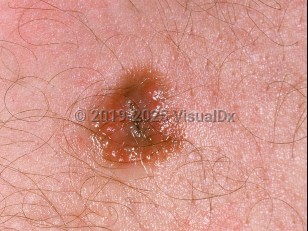Spitz nevus in Adult
Alerts and Notices
Important News & Links
Synopsis

Spitz nevus (spindle and epithelial cell nevus) is a benign melanocytic nevus that classically appears as a less than 5-6 mm dome-shaped, symmetric, smooth, pink-to-red papule on the head, neck, or lower extremities. In adults, these lesions may appear as deeply pigmented, red-brown, or dark brown in color.
Since its initial description by Sophie Spitz in 1948, the importance of this lesion type has resided in its distinction from melanoma. While the classic Spitz nevus, as discussed here, can generally be distinguished from frank melanoma, there is also a spectrum of melanocytic proliferations with a spitzoid appearance and some atypical features (sometimes referred to as atypical Spitz tumor or AST) that fall somewhere in between and are difficult to classify.
Classic Spitz nevi are asymptomatic. Spitz tumors present commonly in patients younger than 30 years (76% of tumors) and often in those younger than 15 years (40% of tumors). The majority of lesions are solitary, but, rarely, they can be multiple and widespread (eruptive disseminated) or localized (agminated) in one area. Widespread Spitz nevi have been reported with pregnancy, puberty, chemotherapy, and HIV. Spitz nevi tend to grow quickly, often within a period of 6 months, and then remain stable.
Spitz proliferations with atypical features, including benign ASTs and malignant Spitz melanomas, may prove difficult to differentiate. The term atypical Spitz nevus is given to lesions that have one or more atypical features, including presentation in late adolescence or older, diameter larger than 1 cm, ulceration, subcutaneous fat involvement, and mitoses. These features pose an increased risk of metastasis. Diagnosis and management can often be controversial, as the malignant potential of ASTs continues to be debated.
Related topic: agminated nevus
Since its initial description by Sophie Spitz in 1948, the importance of this lesion type has resided in its distinction from melanoma. While the classic Spitz nevus, as discussed here, can generally be distinguished from frank melanoma, there is also a spectrum of melanocytic proliferations with a spitzoid appearance and some atypical features (sometimes referred to as atypical Spitz tumor or AST) that fall somewhere in between and are difficult to classify.
Classic Spitz nevi are asymptomatic. Spitz tumors present commonly in patients younger than 30 years (76% of tumors) and often in those younger than 15 years (40% of tumors). The majority of lesions are solitary, but, rarely, they can be multiple and widespread (eruptive disseminated) or localized (agminated) in one area. Widespread Spitz nevi have been reported with pregnancy, puberty, chemotherapy, and HIV. Spitz nevi tend to grow quickly, often within a period of 6 months, and then remain stable.
Spitz proliferations with atypical features, including benign ASTs and malignant Spitz melanomas, may prove difficult to differentiate. The term atypical Spitz nevus is given to lesions that have one or more atypical features, including presentation in late adolescence or older, diameter larger than 1 cm, ulceration, subcutaneous fat involvement, and mitoses. These features pose an increased risk of metastasis. Diagnosis and management can often be controversial, as the malignant potential of ASTs continues to be debated.
Related topic: agminated nevus
Codes
ICD10CM:
D23.9 – Other benign neoplasm of skin, unspecified
SNOMEDCT:
254811006 – Epithelioid and spindle cell nevus
D23.9 – Other benign neoplasm of skin, unspecified
SNOMEDCT:
254811006 – Epithelioid and spindle cell nevus
Look For
Subscription Required
Diagnostic Pearls
Subscription Required
Differential Diagnosis & Pitfalls

To perform a comparison, select diagnoses from the classic differential
Subscription Required
Best Tests
Subscription Required
Management Pearls
Subscription Required
Therapy
Subscription Required
References
Subscription Required
Last Reviewed:09/25/2024
Last Updated:09/26/2024
Last Updated:09/26/2024
Spitz nevus in Adult

